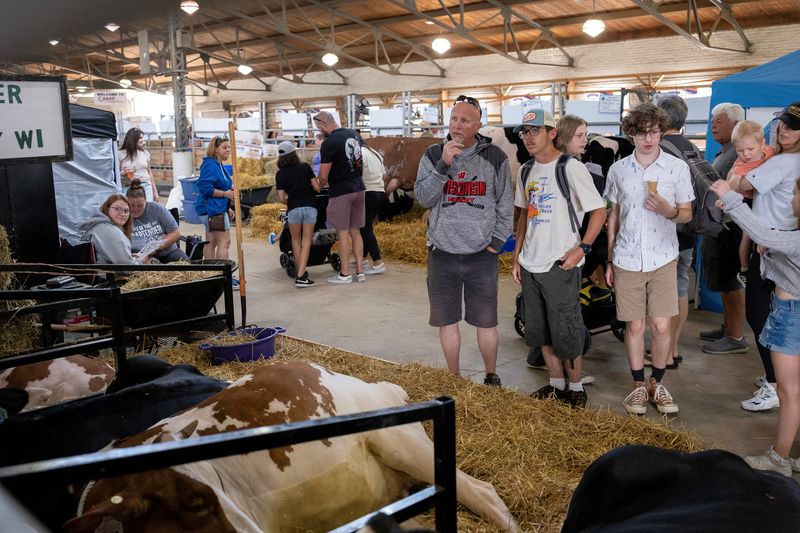
By Tom Polansek and P.J. Huffstutter
WEST ALLIS, Wisconsin (Reuters) – In Michigan this year, where dairy workers and herds have fallen ill from bird flu, a pair of unlikely prized cows are being prepped to take the state fair stage.
State fair organizers are this year featuring Milkshake and Buttercup, two life-sized fiberglass cows complete with rubber teats and water-filled udders, for a popular milking demo.
The head of the Minnesota State Fair’s Moo Booth came up with a similar work around for its hands-on milking event: a fake dairy cow named Olympia.
“Normally, we’d have a real cow out there,” said Jill Nathe, the fair’s deputy general manager of agriculture and competition. “We just can’t do that right now.”
As avian influenza continues to spread, infecting cattle herds for the first time this year as well as four dairy workers, U.S. state and county fair organizers have been forced to reimagine nostalgic summer traditions long celebrated by city and rural folk alike.
For farmers and students eager for blue ribbons and bragging rights, the outbreak has forced them to navigate new testing rules and manage logistical headaches in order to obtain a clean bill of health for animals before entering the show ring.
State and local officials say they are trying to protect people and animals from the H5N1 virus as some dairy farmers have declined to test their herds. Experts worry that further transmission of the virus could help it adapt to spread between humans.
The risk of viral spread among herds prompted some county fairs in Michigan to cancel dairy shows, while the Iowa State Fair shuttered its milking barn.
In Minnesota, state fair staff procured extra gloves and face shields from COVID-era stockpiles for the livestock crew, and kept pregnant dairy cows out of the fair’s birthing center.
Several farm states, including Wisconsin, required lactating cattle to test negative within seven days of arriving at the fairgrounds.
Wisconsin dairy farmer Rick “RT” Thompson said he had to carefully time visits from his veterinarian, so the milk test results for H5N1 would fall within the required window for different fairs. His vet’s wife personally drove samples to a state lab in Madison to ensure they arrived on time for testing.
“It’s not a convenient thing,” said Thompson, 57, who has attended Wisconsin’s state fair for 46 years.
Michigan banned lactating cows from all public exhibitions until the state goes two months without finding an infected herd. With only one state fair per year, the chance has passed for 2024. Michigan last reported a case on Monday.
“We were all waiting for that 60-day window,” Michigan State Fair livestock director LC Scramlin said. “But we kept having another case and another one happen.”
COWS STAY HOME
At the Wisconsin State Fair, where visitors can buy everything from cream puffs to hot tubs, veterinarians inspected cattle before they stepped off their trailers to make sure the animals were healthy upon arrival – a departure from previous years, exhibitors said.
The risk of bird flu was enough to convince Jennifer and Bethany Droessler to keep a lactating cow at home. The sisters from Cuba City, Wisconsin, instead hauled other cattle to show at the event’s Dairy Lane, where fairgoers petted and took selfies with animals topping the scales at more than 1,000 pounds (454 kg).
“We’ll aim for next year and hopefully it won’t be an issue,” said Jennifer Droessler, 30.
More than 190 dairy herds nationwide have been infected since March, and 13 farm workers tested positive following exposure to cows and poultry.
The workers all recovered, and the U.S. Centers for Disease Control and Prevention says H5N1 remains a low risk for the general public. Still, CDC is advising people not to eat, drink or touch anything in animal areas at fairs.

Several fairgoers in Wisconsin, the No. 2 milk-producer and top cheese-making state, said they were not aware of, or concerned about, the guidelines. Visitors chomped on treats including taffy apples and cheese curds as they strolled between cows chewing their cud.
“I don’t think it’s a big risk,” said O.E. Glieber of Delafield, Wisconsin, 88, who came to the fair with grandchildren. “The CDC overreacts with a lot of stuff.”
This post is originally published on INVESTING.



